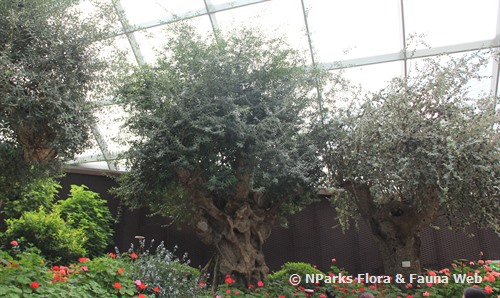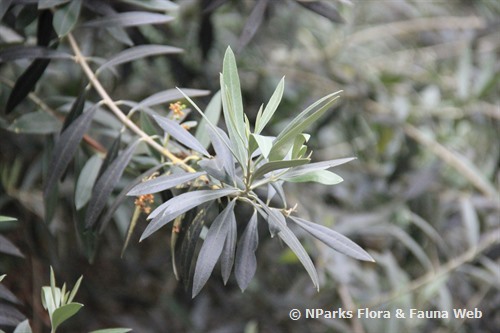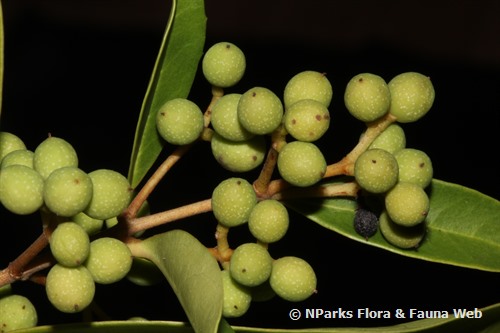
Name
Classifications and Characteristics
| Plant Division | Angiosperms (Flowering Seed Plants) |
|---|---|
| Plant Growth Form | Tree |
Biogeography
| Native Distribution | Unknown, possibly Africa, Mediterranean to South and Central China |
|---|---|
| Native Habitat | Terrestrial |
| Preferred Climate Zone | Mediterranean |
| Local Conservation Status | Non-native |
Description and Ethnobotany
| Growth Form | It is a tree, up to 15 m tall, with trunks that gnarl with age. |
|---|---|
| Foliage | Leaves are narrowly elliptic (3 – 9 cm long and 0.3 – 3 cm wide), leathery and covered in dense peltate scales, which gives a silvery appearance. |
| Flowers | Occurring in clusters, flowers are small, tubular, cream coloured and fragrant. Each flower comprises of 4 valvate lobes, 2 stamens, and a bottle-shaped ovary. |
| Fruit | Fruit occurs as a drupe (0.5 – 4 cm long), green at first and ripening black, with a single hard endocarp within. |
| Etymology | Olea, is Greek for oil and also the ancient name for olive. |
| Ethnobotanical Uses | Edible Plant Parts : Edible Fruits Food (Herb or Spice) Others: Olea europaea is arguably one of the oldest known cultivated plant, probably cultivated about 6000 years ago. The Greek word for oil (eleon) and the Greek word for mercy (eleos) is very similar; and Olea , which is also referred to as oil in ancient Greece, is depicted in old literature such as Shakespeare, Sophocles, Aeschylus as a symbol of peace. In ancient Olympic games, winners were crowned with wreaths made of olive branches. Olive branches are also featured in the flag of United Nations Organization, symbolizing longevity, purification, strength, prosperity, wisdom, victory and peace. Fruit are edible but with a bitter and astringent taste, hence it is often eaten pickled or salted. Fruit are rich in olive oil which has many uses, such culinary, cosmetic, soap-making and medicinal purposes. Mediterranean people use the leaves to make herbal teas as they are high in antioxidant and antimicrobial activity |
Landscaping Features
| Desirable Plant Features | Ornamental Form, Fragrant |
|---|
Plant Care and Propagation
| Light Preference | Full Sun |
|---|---|
| Water Preference | Little Water |
| Plant Growth Rate | Slow |
| Rootzone Tolerance | Well-Drained Soils |
Foliar
| Foliage Retention | Evergreen |
|---|---|
| Mature Foliage Colour(s) | Green, Silver / Grey |
Floral (Angiosperm)
| Flower Colour(s) | Cream / Off-White |
|---|
Fruit, Seed and Spore
| Mature Fruit Colour(s) | Black |
|---|
References
| References | Green, P. S. 2002. A Revision of Olea L. (Oleaceae). Kew Bulletin . 57 (1) . 91 - 140 Rhizopoulou, S.. 2007. Olea europaea L. A Botanical Contribution to Culture. American-Eurasian Journal of Agriculture & Environmental Science. 2 (4). 382 - 387 Umberto Quattrocchi, F.L.S. 2012. CRC World Dictionary of Medicinal and Poisonous Plants: Common Names, Scientific Names, Eponyms, Synonyms, and Etymology . CRC Press. 3960 |
|---|
Image Repository
Others
| Master ID | 30186 |
|---|---|
| Species ID | 4495 |
| Flora Disclaimer | The information in this website has been compiled from reliable sources, such as reference works on medicinal plants. It is not a substitute for medical advice or treatment and NParks does not purport to provide any medical advice. Readers should always consult his/her physician before using or consuming a plant for medicinal purposes. |


